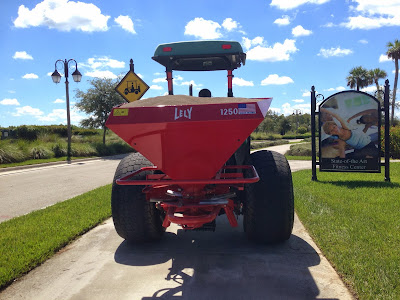Our final aerification of the year was set to take place on September 9th and 10th. With only two days allotted we decided to focus on the greens. Due to the inclement weather we had to extend aerification by a day, which allowed us to complete everything that needed to be done in order for the greens to be healthy going into season.
The first step in the process was to veritcut all the greens. We have done this same process the past two aerifications as well. This time it was decided that we would verticut twice in the same direction in order to clear well defined channels in the turf's canopy. The spacing between verticutter blades was closed down to 1/2" from 1" in our previous aerifications. The verticutters were not set as deep this go around because cores were also pulled from the greens.
 |
| Verticutter blades set a 1/2" spacings |
After verticutting we aerified the greens using a Toro Procore 648. This aerification we decided to use a smaller tine and pull cores rather than just punching holes with a wider tine. The greens were first topdressed with sterile topdressing sand. We used 1/4" side eject tines mounted to the quad blocks of the 648. Taking cores allowed us to pull thatch from deeper areas of the green than verticutting alone. It also allows for more air and water flow through the green.
 |
| Three passes completed on #18 green. |
The cores were then broken up using a steel drag mat. This allows the soil and sand to break away from the grass and thatch. A blower was then used to remove the grass and thatch from the putting surface, leaving only the sand and soil.
After blowing away debris we used a 2 ton roller to ensure there were no ruts in the greens from topdressing or aerifying. When the roller was finished on each green a bunker rake fitted with a drag brush was used to work the sand into the surface of the green. This process was done daily for the 4 days following aerification.
 |
2 ton roller smoothing and firming #7 green.
|
Our final aerification, although wet, was very successful. With these management practices the agronomy team here at Jupiter CC feel that the greens are in great shape and we are excited to keep them that way come season.












































